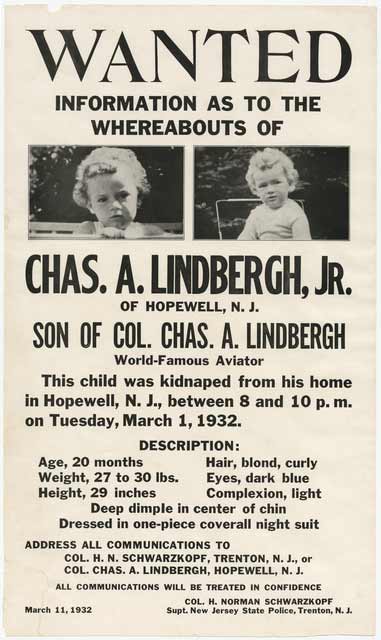Many people commit crime for money, some for love, and then there are those who'd go at extreme lengths for fame. But what does it take to become a successful criminal, if your goal is just to be remembered?
The Crime of the Century
The crime of the century (the 20th century that is, which makes it pretty ancient today) was the kidnapping of the 18 months' old Charles Augustus Lindbergh, Jr., son of famous aviator Charles Lindbergh and Anne Morrow Lindbergh. A gigantic man-hunt followed, kidnapping became a federal crime and thus the FBI got involved, one of the witnesses committed suicide due to violent police tactics, and, after the child's body was discovered, Bruno Hauptmann (one of the names we should forget) was arrested and sentenced to death in a circus-trial.
What's more interesting is that, during the investigation, over 200 people came forward with false confessions, claiming to have kidnapped the child. Their motivation? They wanted their names in the newspapers. In fact, studies suggest that most voluntary false confessions are driven by the same motivation: fame. (How unimaginative. Go commit your own crimes, the real criminals must think.)
Let's Just Remember John
Also in the ancient 20th century, there was a guy who identified himself with Holden Caulfield from Catcher in the Rye and with Dorothy from the Wizard of Oz. That's not a crime, is it? It also won't make you famous. So this guy, Mark David Chapman (one of the names we should forget), found another method. 25 years later, he pretty much admitted that he killed John Lennon for fame: "The result would be that I would be famous, the result would be that my life would change and I would receive a tremendous amount of attention, which I did receive.”
The Media is to Blame... Not
Let's turn off MTV for a moment to get real ancient here, with one of the Seven Wonders of the World: the Temple of Artemis in Ephesus, possibly the first Greek temple made in marble, with columns standing about 40 feet high. When it was completed, the temple became an instant hit and a major tourist attraction... for a very short while.
On July 21, 356 BC (notice how exact we are with dates here), Herostratus set the temple on fire, for the sole purpose of getting his name remembered for generations. Apparently, for every seven wonders of the world, there is one maniac who'd do anything for fame. The catch here is that messing with a wonder of the world may get you a little more than the regular 15 minutes of fame, as Herostratus proves. (We know the exact date because it's also the day when Alexander the Great was born. Plutarch, with his weird sense of humor, noted that the goddess Artemis was too busy delivering Alexander to take care of her own temple that day.)
Herostratus was swiftly put on trial and sentenced to death, but the judges of the time also instituted a more appropriate punishment: his name was to be erased from all documents, and nobody was to mention him anymore, under threat of death. Appropriate punishment, but nonetheless an epic fail: two thousand years later we still have the phrase Herostratic fame and the German word Herostrat, meaning basically somebody who commits crime just for glory.
Fortunately, today we no longer have to destroy a wonder of the world to get famous. That's what Facebook is for.






